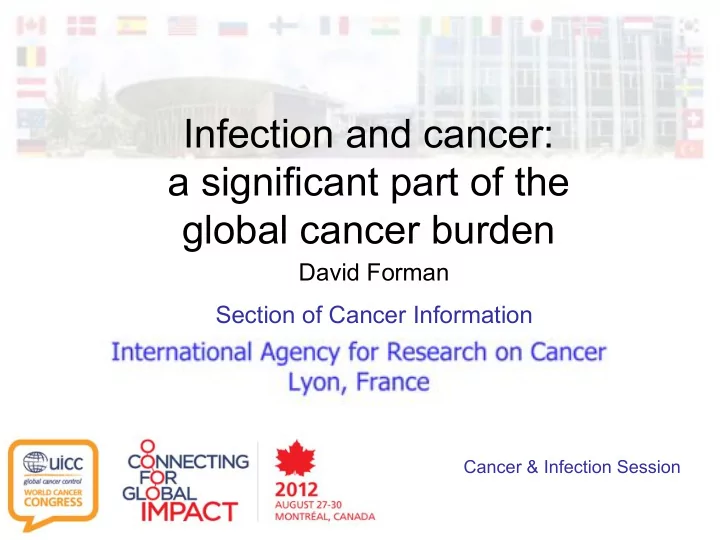

Infection and cancer: a significant part of the global cancer burden David Forman Section of Cancer Information Cancer & Infection Session
Global burden of cancers attributable to infections in 2008 Goals • Estimate the number of incident cancers attributable to infection worldwide: – Geographic distribution. – Relation to total cancer burden – Assess global cancer impact of most important infectious agents • Help set regional priorities for cancer control • Update previous estimates for 1990 and 2002
Monograph 100. A review of human carcinogens Part B: Biological agents (February 2009) http://monographs.iarc.fr/ENG/Monographs/vol100B/
Global burden of cancers attributable to infections in 2008 • GLOBOCAN 2008 (globocan.iarc.fr) estimates of cancer incidence, mortality and prevalence in the year 2008 – 184 countries – 27 cancer sites • We extended estimates to include sub-sites associated with infection. • Incidence estimates were aggregated into eight geographic regions.
Global burden of cancers attributable to infections in 2008 • 12.7 million cancer cases (Globocan 2008) • 2.0 million (16%) attributable to infection – 22.9% in less developed countries – 7.4% in more developed countries • 10-fold variation between regions – 32.7% in Sub-Saharan Africa – 3.3% in Australia and New Zealand
Fraction of new cancer cases attributable to infection: Population attributable fraction (PAF) by world regions
Number of new cancer cases occurring in 2008 attributable to infectious agents by anatomic site �������� ���������� ���������
Global burden of cancers attributable to infections in 2008 Cancer site Global incidence Number Population estimate attributable to Attributable infection Fraction (%) Gastric (non-cardia) 870,000 650,000 74.7 Liver 750,000 580,000 76.9 Cervix uteri 530,000 530,000 100 Nasopharynx 84,000 72,000 85.5 Kaposi’s sarcoma 43,000 43,000 100 All other 893,000 168,000 Total 2 million de Martel et al. (Lancet Oncol, 2012)
Number of new cancer cases attributable to infection in 2008 by development status Numbers are rounded to two significant digits
Number of new cancer cases attributable to infection in 2008 by development status Less developed regions Thousands new cases More developed regions
Relative percentage of new cancer cases attributable to infection by sex, age group, and development status
Human papillomavirus • HPV is a necessary cause of cervical cancer • Prevalent in other anogenital cancers: – Penis: 50% – Anus: 88% – Vulva: 43% – Vagina: 70% • Found in a sub-set of oropharyngeal cancers (oropharynx, including tonsils and base of tongue) – Prevalence from 56% (N America) to 13% (Outside Europe, N America, Australia & New Zealand, Japan)
Cancers attributable to HPV Worldwide, cervical cancer dominates the HPV-associated cancers In N America, where cervical cancer is controlled by screening, HPV-associated cancers at other sites are equally important.
Hepatitis viruses • Both HBV and HCV are strong risk factors for liver cancer (R ~ 20) • HCV is also associated with non-Hodgkin lymphoma (PAF=8%) • Strong geographical variation in prevalence of both HBV and HCV in liver cancer cases.
Prevalence of HBV in cases of hepatocellular carcinoma 0 86.1
Prevalence of HCV in cases of hepatocellular carcinoma 0 78.7
Helicobacter pylori • H. pylori is a risk factor for gastric cancer, but risk is restricted to non-cardia location. • H. pylori is also associated with non-Hodgkin lymphoma of gastric location (MALT and DLBC), PAF=74% • Once acquired (usually in childhood), infection tends to be lifelong • Treatment is c. 90% effective with a combination of antibiotics and acid lowering drugs • Screen and treat is a policy that may be an effective means of preventing gastric cancer – not yet adequately evaluated
Comparison of other estimates of proportion of cancers attributable to infection • World (2002) – 17.8% (Parkin 2006) vs 16.1% • China – 25.9% (Xiang et al 2011) vs 26.1% • South Korea – 21.2% (Shin et al 2011) vs 22.5% (E Asia) • UK – 3.1% (Parkin 2011) vs 7.0% (Europe) or – vs 4.0% (N America)
Global burden of cancers attributable to infections in 2008 Conclusions • Wide geographic variation in the fraction of cancers attributable to infection. • Almost a quarter of all cancers in less developed countries have an infectious cause. • Importance of HPV, H. pylori , HBV, and HCV as main cancer-related infectious agents. • Available strategies for prevention – vaccination against HBV and HPV – use of safe injection practices and avoidance of parenteral treatment for HCV – antibiotics for control of H. pylori (requires evaluation)
Global burden of cancers attributable to infections in 2008 Infection and Cancer Section of Cancer Information Epidemiology Group • Jacques Ferlay • Catherine de Martel • Freddie Bray • Martyn Plummer • David Forman • Jerome Vignat • Silvia Franceschi De Martel C, Ferlay J, Vignat J, Franceschi S, Bray F , Forman D, and Plummer M. Global burden of cancers attributable to infections in 2008: A review and synthetic analysis. Lancet Oncology ,13:607-15, 2012
Recommend
More recommend